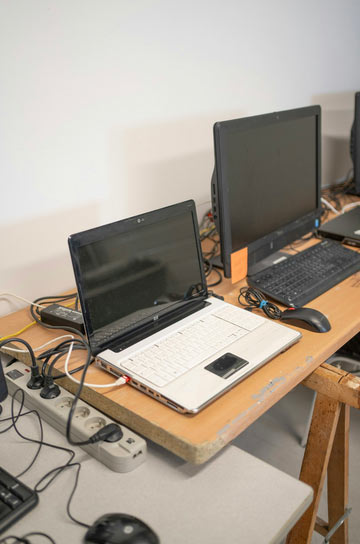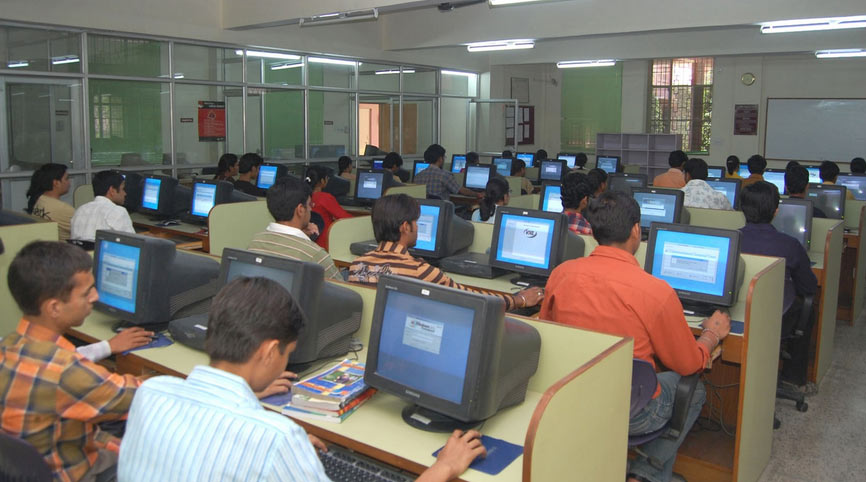How To Conduct Online Exam: Step-By-Step Process, Security, And Tips For Challenges
Setting up an online exam? It’s not just about making questions. You need to ensure fairness, prevent cheating, and avoid tech issues.
A poorly planned exam can lead to confusion, errors, or even cheating. But don’t worry. With the right steps, you can create a smooth and secure online test.
Drawing from our experience with leading universities like Symbiosis and others, at Ekklavya, we understand what it takes to make online assessments secure and efficient. This guide will show you how to conduct online exams at home. So, let’s get moving.

How To Conduct Online Exam?
Online exams are an alternative way of conducting exams. Candidates can sit remotely in front of a computer and attempt the exam. While traditional pen-and-paper exams are still relevant, online exams provide a more scalable and convenient alternative, especially for remote assessments. However, conducting an online exam demands a structured approach.
A successful online exam starts with clear rules and guidelines. This ensures transparency and prevents disputes. Here’s what you should focus on:
Sign up for a Reliable Online Exam Software: As the examiner or teacher, you must first sign up for an online exam conducting software. Ekklavya ePareeksha is the best online exam software offering a cheat-proof experience. It supports essential features like question management, time tracking, and real-time proctoring.
Define the exam format: Is it an objective or subjective exam ? Establish the type:
MCQ-based tests (Objective, quick to grade)
Written exams (Long-form answers, subjective assessment)
Hybrid format (Combination of both for comprehensive evaluation)
Set conduct rules for candidates: To maintain academic integrity, institutions should implement strict exam guidelines. Some key rules include:
Tab switching restrictions to prevent internet searches.
External resource limitations – specify if books, calculators, or notes are allowed.
Live monitoring setup – inform candidates if their webcam and microphone will be required.
When students know the consequences of cheating or misconduct, they are less likely to engage in dishonest behaviour.
Time and structure: Exams should have a structured time frame to ensure students manage their responses effectively. Inform candidates about time limits and section divisions.
How much time is allocated for each section? (e.g., 60 minutes, 90 minutes, etc.) This will help them manage their time effectively and reduce anxiety.
Are there any time limits on per-question?
Communicate Technical Requirements: List the devices, browsers, and software needed for compatibility.
Communicate Technical Requirements: List the devices, browsers, and software needed for compatibility.
Compatible devices (Laptop, PC, or tablet)
Stable internet connection (5 Mbps or higher recommended)
Allowed browsers (Chrome, Firefox, Edge, etc.)
To avoid last-minute confusion, colleges and schools can conduct mock exams to test network and system performance before the actual exams. This way, if there are any issues with the online exam software, they can be investigated.
Pre-exam briefing: Share step-by-step instructions via email, video tutorials, or a dedicated webpage. Instructions should also include:
Login credentials and exam portal link
Exam start and end time
Proctoring requirements (Webcam, microphone, etc.)
What Steps Should I Follow To Create An Online Exam?
Creating an online exam involves several carefully planned steps. Here’s a step-by-step breakdown from planning to publishing your exam:
Step 1: Choose The Right Exam Platform
Pick a secure and user-friendly campus automation platform that meets your institution's needs. Look for features like:
Customizable question banks and paper templates
Multimedia support for various exams and question types.
Automated grading for OMR sheets
Easy integration with learning management systems.
Built-in security measures like two-factor authentication, encryption, and biometric solutions to prevent cheating.
Step 2: Upload Questions and Set Parameters
Input your questions into the platform, organizing them into categories or difficulty levels. Set parameters such as time limits, randomization of questions, and navigation restrictions to enhance security.
Step 3: Configure Proctoring Settings
Proctoring is a must for high-stakes exams. It is up to you to decide on the level of proctoring required:
Live proctoring (human invigilation via webcam)
AI-based monitoring (detects suspicious activity automatically)
Secure browser mode (prevents switching between apps/tabs)
Ensure that the proctoring method aligns with your institution's privacy policies and technical capabilities.
Step 4: Conduct a Pilot Test
Run a mock exam with a small group to identify any technical glitches or areas of confusion. Use feedback to make necessary adjustments before the actual exam.
Step 5: Communicate with Candidates
Send detailed instructions to candidates well in advance, covering technical requirements, exam rules, and support contact information.
Step 6: Monitor the Exam
During the exam, actively monitor candidates through the chosen proctoring method. Be prepared to address any technical issues promptly.
Step 7: Review and Analyze Results
After the exam, analyze results for patterns that may indicate cheating, such as identical responses or unusually quick completion times. Provide feedback to candidates as appropriate.

Common Challenges While Conducting An Online Exam
Despite best efforts, online exams come with challenges. Being aware of these issues can help educators prepare better and ensure a smoother experience for everyone involved:
Cheating & Misconduct: The best part about online certifications and courses is that they open up the world of learning. But with accessibility comes academic dishonesty. Studies by NIH show that 60% of students cheat in their exams multiple times. Of these, 30% admitted to cheating once. The main reason being lack of proper monitoring.
Technical Glitches: Poor internet connection, browser crashes, electric power interruptions, or server downtime are some of the issues that can disrupt the flow of online assessments. COVID-19 was when the online exam era peaked, and it's unfortunate that 52.6% of students reported encountering technical problems during their tests.
Student Confusion: Poor instructions lead to unnecessary panic and mistakes. Implementing a solution then and there is also impossible due to distance, as it may take time and resources.
Exam Integrity Issues: Some students may try to bypass security measures. When the distance is high and there’s no face-to-face interaction, students tend to take studies lightly. They either team up or individually resort to cheating.
How Are Online Exams Conducted At Home?
Conducting exams from home is now common. Unlike center-based exams, home-based tests require students to manage their own environment. Online exams from home bring you:
Independence: You don't have an invigilator overseeing you in the exam hall. Instead, technology and proctors are monitoring your activity.
Flexibility: Students can take exams in a comfortable setting and at a time that suits them.
Reduced Commute Time: With online exams, you can eliminate the need to travel to an exam center and save time and energy.
However, with the benefits come potential challenges like a higher risk of academic dishonesty, distractions, and technical issues.
To address these concerns, here are some tips for creating a fair at-home test environment:
Choose a Quiet Space: Students should find a distraction-free room with minimal noise to take exams.
Inform Household Members: Let others know your exam schedule to avoid disturbances.
Check Technical Equipment: Ensure your computer, webcam, and internet connection are reliable.
Clear the Workspace: Remove unauthorized materials to comply with exam rules.
Test the Setup: Run a practice exam to identify and fix potential issues beforehand.
How To Conduct an MCQ Exam Online?
Multiple-choice question (MCQ) exams are popular for their efficiency and ease of grading. You can use MCQ creation tools and platforms like Google Forms, Quizizz, etc.
How To Proctor An Online Exam And Prevent Cheating?
Online proctoring uses live human monitoring or automated software. You must go for both a human proctor and AI-based proctor for the best exam monitoring to prevent cheating.
AI proctors come with browser lockdown that can restrict access to other applications. While human proctors can easily catch eye movements and suspicious activity.
Suppose, a person has someone in the room telling them the answers. A human proctor can access that by audio or facial expressions.

What Are The Technical And Logistical Requirements For Online Exams?
To conduct an online exam you need:
A device (Laptop or Computer) with a webcam built in.
Microphone must be working to monitor audio during the test.
A strong Wi-Fi connection with at least 8 mbps speed.
Compatibility with common web browsers (Chrome, Firefox, Safari).
How Do I Build A Question Bank For An Online Exam?
Building a well-organized question bank is essential for creating fair and effective online exams. Below are simple steps to build an effective question bank:
Categorize Questions by Topic and Difficulty
Organize questions into subject-wise categories to allow easy retrieval.
Label them as easy, medium, or difficult to create balanced assessments.
Source Questions from Reliable Materials
Use previous exams, textbooks, and academic resources.
Incorporate real-world scenarios to enhance application-based learning.
Leverage MCQ Question Bank Software
MCQ question bank software can help streamline the process of creating an exam test paper from scratch. With a question bank, you can:
Easily categorize questions.
Track question usage and performance.
Generate randomized exam paper sets with jumbled question synchronization.
Remember to make regular updates to the question bank to ensure freshness. You can do so by adding new questions and removing outdated or redundant questions to maintain quality.

How To Monitor And Manage Exam Progress In Real-Time?
To monitor and manage the online exam progress of students:
Use analytics dashboards or live viewing tools.
Identify suspicious activity through alerts.
Help students facing lags or drop-offs.
How To Grade Online Exams And Provide Feedback?
Grading online exams and giving helpful feedback is important for helping students learn. Here are two simple ways to do it:
1. Auto-Grading for Objective Papers
If it's for objective questions like MCQs, then you can opt for OMR evaluation software to grade the tests. Here, you don't need to check the answers manually. Most online exam platforms have built-in functionality to score these types of questions automatically. This helps you:
Save time checking each set of paper
Ensure fairness in checking without making mistakes.
2. Manual Grading for Subjective Questions
For longer answers like essays or case study problems, you will need to grade them manually. Here are some tips:
Use a grading guide to make sure you’re fair and consistent.
Write comments on the student’s work to highlight what they did well and what they could improve.
Think about adding a peer review option, where students can review each other’s work.
After grading, give students a result breakdown. This can include:
Scores for each section of the exam.
Overall percentage correct.
Information on areas where they did well or struggled.
Lastly, a simple feedback text message like, “Thank you for taking the test! Please fill out the feedback form to help us improve your experience." goes a long way. This is to encourage post-exam reflection and doubt clearing.
Frequently Asked Questions About How To Conduct Online Exam
Start by defining the rules and regulations to abide by, choosing a secure platform, and implementing robust proctoring methods (human or AI-powered). Lastly, communicate the same to students.
Handling technical glitches, infrastructure and network issues, and students bypassing proctors and indulging in cheating are some of the challenges of online exam software.